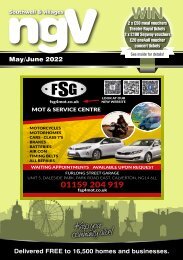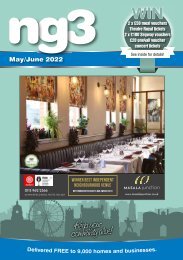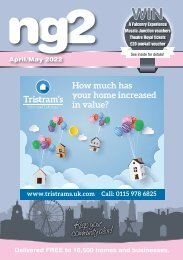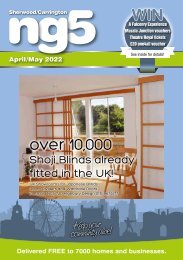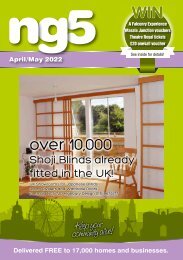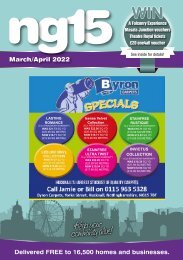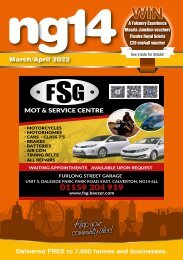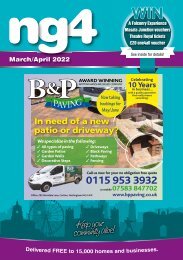NG Four January/February 2020
Local business directory and community magazine.
Local business directory and community magazine.
Create successful ePaper yourself
Turn your PDF publications into a flip-book with our unique Google optimized e-Paper software.
Carlton’s Victoria Picture Palace<br />
by Bob Massey<br />
By 1912 there were two cinemas operating in<br />
Arnold.<br />
The first was a simple building of timber and<br />
galvanised iron, officially called the Electric<br />
Picture Palace, but fondly known locally as the<br />
Tin Hut. The second cinema that followed soon<br />
after was a very different affair.<br />
The St Albans Picturedrome was one of the first<br />
of the true picture palaces that graced the area<br />
during the 1920s and 30s. A very impressive<br />
building .<br />
Enoch Parker was a local Carlton businessman<br />
and building contractor who could see that the<br />
cinema was here to stay. He had visited the St<br />
Albans Picturedrome and decided that it was<br />
just what Carlton needed. Parker acquired<br />
a plot of land on Station Road which he felt<br />
would be an ideal site for this new venture. He<br />
approached William Higginbottom, the architect<br />
who had designed the St Albans Picturedrome,<br />
to design him a cinema for Carlton.<br />
Cinema design was very much a new discipline<br />
at the time and using someone who had some<br />
experience in the field was very important as<br />
they were few and far between.<br />
W H Higginbotton submitted his plans for the<br />
new building in autumn 1912 and in October<br />
that year the Carlton Urban District Council<br />
approved the drawings. Work on the building<br />
started in <strong>January</strong> 1913 with construction<br />
carried out by Enoch Parkers own company.<br />
A generator was installed to provide the DC<br />
power required for the projector. The rest of the<br />
building was lit by gas. The audience of 450 was<br />
accommodated on a staggered level auditorium<br />
in simple wooden tip up seats. Admission was<br />
3d and 6d with the six penny seats in the grand<br />
stalls (the slightly raised area at the back of the<br />
auditorium). The paint work was pink and cream<br />
with curtains to match.<br />
By early spring 1913 the work was completed<br />
and the cinema officially opened on April<br />
30th 1913, less than 4 months after the work<br />
commenced.<br />
This new entertainment venue for Carlton was<br />
called the Victoria Picture House. The films<br />
being shown were of course all silent in those<br />
days, but they were accompanied in this building<br />
by a piano, violin and cello. The first film to be<br />
shown was Willies Magic Wand, supported by<br />
a short slapstick comedy and a topical review.<br />
The great liner, the Titanic, had sunk with a large<br />
loss of life only a few days before and Pathe had<br />
produced a news report. This was also shown<br />
as part of the same programme that night.<br />
Mr Parker decided to run the cinema himself<br />
and could be seen in the building most nights.<br />
The projection of the films was carried out by<br />
Mr Parker’s son Reginald as chief operator. It<br />
was very much a family undertaking from start<br />
to finish.<br />
The cinema quickly became a great success<br />
and was regularly filled to capacity. In 1921<br />
after 10 years of operation, the cinema closed<br />
for a short time while a balcony was installed.<br />
When it reopened on November 21st 1921 the<br />
capacity had increased to 600. The cinema now<br />
had a staff of 16 with Reginald taking over the<br />
management from his father. Arthur Davies<br />
replaced Reginald as chief operator. Cinema in<br />
Carlton was now well established.<br />
Are you a budding historian and have an interest in local history? We are looking for a regular<br />
contributor for our new <strong>NG</strong><strong>Four</strong> magazine. Email: ali@ngmagazines.org.uk





